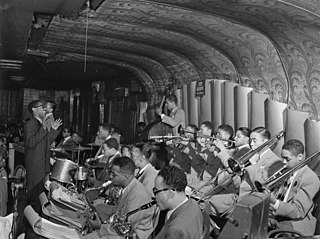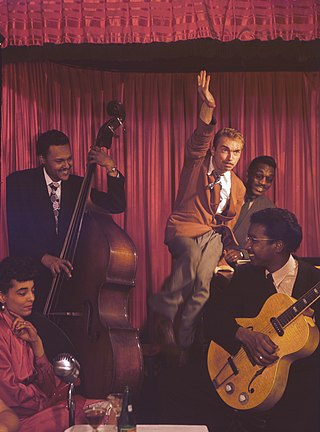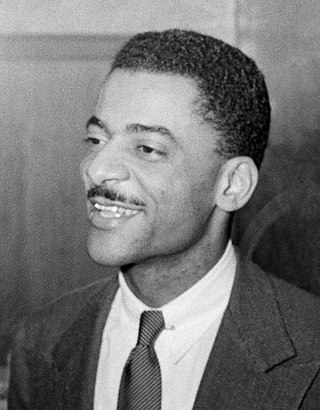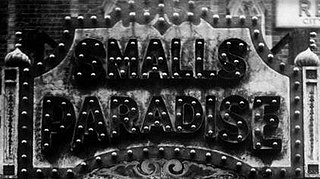
The Savoy Ballroom was a large ballroom for music and public dancing located at 596 Lenox Avenue, between 140th and 141st Streets in the Harlem neighborhood of Manhattan, New York City. Lenox Avenue was the main thoroughfare through upper Harlem. Poet Langston Hughes calls it the "Heartbeat of Harlem" in Juke Box Love Song, and he set his work "Lenox Avenue: Midnight" on the legendary street. The Savoy was one of many Harlem hot spots along Lenox, but it was the one to be called the "World's Finest Ballroom". It was in operation from March 12, 1926, to July 10, 1958, and as Barbara Englebrecht writes in her article "Swinging at the Savoy", it was "a building, a geographic place, a ballroom, and the 'soul' of a neighborhood". It was opened and owned by white entrepreneur Jay Faggen and Jewish businessman Moe Gale. It was managed by African-American businessman and civic leader Charles Buchanan. Buchanan, who was born in the British West Indies, sought to run a "luxury ballroom to accommodate the many thousands who wished to dance in an atmosphere of tasteful refinement, rather than in the small stuffy halls and the foul smelling, smoke laden cellar nightclubs ..."
A rent party is a social occasion where tenants hire a musician or band to play and pass the hat to raise money to pay their rent, originating in Harlem during the 1920s. These parties were a means for Black tenants to eat, dance, and get away from everyday hardship and discrimination. The rent party played a major role in the development of jazz and blues music, alongside forms of swing dancing. The Oxford English Dictionary states that the term skiffle means "rent party", indicating the informality of the occasion. Thus, the word became associated with informal music. However, many notable jazz musicians are associated with rent parties, including pianists Speckled Red, Georgia Tom, Little Brother Montgomery, James P. Johnson, Willie "the Lion" Smith, and Fats Waller, although rent parties also featured bands as well. The OED also gives boogie as a term meaning 'rent party'.

Ethel Waters was an American singer and actress. Waters frequently performed jazz, swing, and pop music on the Broadway stage and in concerts. She began her career in the 1920s singing blues. Her notable recordings include "Dinah", "Stormy Weather", "Taking a Chance on Love", "Heat Wave", "Supper Time", "Am I Blue?", "Cabin in the Sky", "I'm Coming Virginia", and her version of "His Eye Is on the Sparrow". Waters was the second African American to be nominated for an Academy Award, the first African American to star on her own television show, and the first African-American woman to be nominated for a Primetime Emmy Award.

A speakeasy, also called a blind pig or blind tiger, was an illicit establishment that sold alcoholic beverages. The term may also refer to a retro style bar that replicates aspects of historical speakeasies.

The Jazz Age was a period in the 1920s and 1930s in which jazz music and dance styles gained worldwide popularity. The Jazz Age's cultural repercussions were primarily felt in the United States, the birthplace of jazz. Originating in New Orleans as mainly sourced from the culture of African Americans, jazz played a significant part in wider cultural changes in this period, and its influence on popular culture continued long afterwards.

Harry "The Hipster" Gibson, born Harry Raab, was an American jazz pianist, singer, and songwriter. He played New York style stride piano and boogie woogie while singing in a wild, unrestrained style. His music career began in the late 1920s, when, under his real name, he played stride piano in Dixieland jazz bands in Harlem. He continued to perform there throughout the 1930s, adding the barrelhouse boogie of the time to his repertoire.

The Cotton Club was a New York City nightclub from 1923 to 1940. It was located on 142nd Street and Lenox Avenue (1923–1936), then briefly in the midtown Theater District (1936–1940). The club operated during the United States' era of Prohibition and Jim Crow era racial segregation. Black people initially could not patronize the Cotton Club, but the venue featured many of the most popular black entertainers of the era, including musicians Fletcher Henderson, Duke Ellington, Jimmie Lunceford, Chick Webb, Louis Armstrong, Count Basie, Fats Waller, Willie Bryant; vocalists Adelaide Hall, Ethel Waters, Cab Calloway, Bessie Smith, Lillie Delk Christian, Aida Ward, Avon Long, the Dandridge Sisters, the Will Vodery choir, The Mills Brothers, Nina Mae McKinney, Billie Holiday, Midge Williams, Lena Horne, and dancers such as Katherine Dunham, Bill Robinson, The Nicholas Brothers, Charles 'Honi' Coles, Leonard Reed, Stepin Fetchit, the Berry Brothers, The Four Step Brothers, Jeni Le Gon and Earl Snakehips Tucker.

Theodore Shaw Wilson was an American jazz pianist. Described by critic Scott Yanow as "the definitive swing pianist", Wilson's piano style was gentle, elegant, and virtuosic. His style was highly influenced by Earl Hines and Art Tatum. His work was featured on the records of many of the biggest names in jazz, including Louis Armstrong, Lena Horne, Benny Goodman, Billie Holiday, and Ella Fitzgerald. With Goodman, he was one of the first black musicians to perform prominently alongside white musicians. In addition to his extensive work as a sideman, Wilson also led his own groups and recording sessions from the late 1920s to the 1980s.

The Black Bottom is a dance which became popular during 1920s amid the Jazz Age. It was danced solo or by couples. Originating among African Americans in the rural South, the black bottom eventually spread to mainstream American culture and became a national craze in the 1920s. The dance was most famously performed by Ann Pennington, a star of the Ziegfeld Follies, who performed it in a Broadway revue staged by Ziegfeld's rival George White in 1926.

Gladys Alberta Bentley was an American blues singer, pianist, and entertainer during the Harlem Renaissance.

The history of Lindy Hop begins in the African American communities of Harlem, New York during the late 1920s in conjunction with swing jazz. Lindy Hop is closely related to earlier African American vernacular dances but quickly gained its own fame through dancers in films, performances, competitions, and professional dance troupes. It became especially popular in the 1930s with the upsurge of aerials. The popularity of Lindy Hop declined after World War II, and it converted to other forms of dancing, but it never disappeared during the decades between the 1940s and the 1980s until European and American dancers revived it starting from the beginning of the 1980s.
The Hoofers Club was an African-American entertainment establishment and dancers' club hangout in Harlem, New York, that ran from the early 1920s until the early 1940s. It was founded and managed by Lonnie Hicks (1882–1953), an Atlanta-born ragtime pianist.

133rd Street is a street in Manhattan and the Bronx, New York City. In Harlem, Manhattan, it begins at Riverside Drive on its western side and crosses Broadway, Amsterdam Avenue, and ends at Convent Avenue, before resuming on the eastern side, crossing Seventh Avenue, and ending at Lenox Avenue. In Port Morris in the Bronx, it runs from Bruckner Boulevard/St. Ann's Place to Locust Avenue. The block between Seventh Avenue and Lenox Avenues was once a thriving night spot, known as "Swing Street", with numerous cabarets, jazz clubs, and speakeasies. The street is described in modern times as "a quiet stretch of brownstones and tenement-style apartment houses, the kind of block that typifies this section of central Harlem".

Smalls Paradise, was a nightclub in the Harlem neighborhood of Manhattan in New York City. Located in the basement of 2294 Adam Clayton Powell Jr. Boulevard at 134th Street, it opened in 1925 and was owned by Ed Smalls (né Edwin Alexander Smalls; 1882–1976). At the time of the Harlem Renaissance, Smalls Paradise was the only one of the well-known Harlem night clubs to be owned by an African-American and integrated. Other major Harlem night clubs admitted only white patrons unless the person was an African-American celebrity.
The Hot Feet Club was a popular nightclub in New York City that operated from 1928 until 1933, approximately.
The Paradise Club or Club Paradise was a nightclub and jazz club at 220 North Illinois Avenue in Atlantic City, New Jersey. It was one of two major black jazz clubs in Atlantic City during its heyday from the 1920s through 1950s, the other being Club Harlem. Entertaining a predominantly white clientele, it was known for its raucous floor shows featuring gyrating black dancers accompanied by high-energy jazz bands led by the likes of Count Basie, Jimmie Lunceford, and Lucky Millinder. In 1954 the Paradise Club merged with Club Harlem under joint ownership.
Kentucky Avenue Renaissance Festival, also known as the Historical Kentucky Avenue Renaissance Festival, is a street fair held each summer in the former black entertainment district of Atlantic City, New Jersey. Founded in 1992, it appeared annually until 2001, and then resumed in 2011. Held on and around the site of the razed Club Harlem, the weekend fair commemorates the R&B and jazz nightspots that once lined Kentucky Avenue and that attracted both black and white clientele in its heyday from the 1940s through 1960s. The festival features live performances by R&B and jazz musicians and bands, dance performances, street performers, arts and crafts for children, and food concessions, and draws hundreds of attendees.
Margot Webb was a professional dancer trained in ballet, waltz, tango, and bolero. She and her dance partner, Harold Norton, were one of the first African American ballroom teams and were known professionally as “Norton and Margot”.
The Nest Club was a cabaret in Harlem, more specifically an afterhours club, at 169 West 133rd Street – a street known then both as "Swing Street" and "Jungle Alley" – two doors east of Seventh Avenue, downstairs. The club, operating under the auspices of The Nest Club, Inc., was founded in 1923, co-owned, and operated by John C. Carey (né John Clifford Carey; 1889–1956) and Mal Frazier (né Melville Hunter Frazier; 1888–1967). The club flourished through 1933. The U.S. Prohibition — a nationwide ban on the sale of alcoholic beverages — ran from 1920 to 1933. The club faced a formidable challenge to its viability following the Great Crash of October 1929, followed by the Great Depression that bottomed around March 1933.
Black and Tan clubs were nightclubs in the United States in the early 20th century catering to the black and mixed-race ("tan") population. They flourished in the speakeasy era and were often popular places of entertainment linked to the early jazz years. With time the definition simply came to mean black and white clientele.












